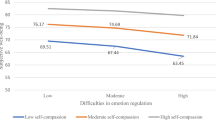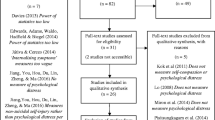Abstract
Child maltreatment-related outcomes range from no symptom expression to suicide. Increasingly, the diverse presentations have been conceptualized as core system dysregulation, including emotion dysregulation. Self-compassion has been advanced as a self-regulation strategy for countering negative self-directed emotions. This study explored whether individual differences in self-compassion would play a role in loosening the associations among childhood maltreatment severity and later emotion regulation difficulties. The sample consisted of transition-age youth (N = 81) seeking treatment for problem substance use. Self-compassion was negatively associated with emotion regulation difficulties and childhood maltreatment, and predicted emotion dysregulation above and beyond maltreatment history, current severity of psychological distress, and problem substance use. In addition, self-compassion mediated the relationship between childhood maltreatment severity and later emotion dysregulation. These findings provide an impetus for further research into the relevance of self-compassion for maltreatment-related impairment.

Similar content being viewed by others
References
American Psychiatric Association. (2000). Diagnostic and statistical manual of mental disorders. Text revision (4th ed.). Washington, DC: American Psychiatric Association.
Baron, R., & Kenny, D. (1986). The moderator-mediator variable distinction in social psychological research: conceptual, strategic, and statistical considerations. Journal of Personality and Social Psychology, 51, 1173–1182.
Bernstein, D. P., Ahluvalia, T., Pogge, D., & Handelsman, L. (1997). Validity of the childhood trauma questionnaire in an adolescent psychiatric population. Journal of the American Academy of Child & Adolescent Psychiatry, 36(3), 340–348.
Bernstein, D. P., & Fink, L. (1998). Childhood trauma questionnaire: A retrospective self-report. Manual. San Antonio: The Psychological Corporation.
Bernstein, D. P., Fink, L., Handelsman, L., & Foote, J. (1994). Initial reliability and validity of a new retrospective measure of child abuse and neglect. American Journal of Psychiatry, 151(8), 1132–1136.
Bernstein, D. P., Stein, J. A., Newcomb, M. D., Walker, E., Pogge, D., & Ahluvalia, T. (2003). Development and validation of a brief screening version of the childhood trauma questionnaire. Child Abuse & Neglect, 27(2), 169–190.
Cameron, I., Cunningham, L., Crawford, J., Eagles, J., & Eisen, S. (2007). Psychometric properties of the BASIS-24 (behaviour and symptom identification scale-revised) mental health outcome measure. International Journal of Psychiatry in Clinical Practice, 11(1), 36–43.
Cheetham, A., Allen, N. B., Yücel, M., & Lubman, D. I. (2010). The role of affective dysregulation in drug addiction. Clinical Psychology Review, 30(6), 621–634.
Cohen, F. S., & Densen-Gerber, J. (1982). A study of the relationship between child abuse and drug addiction in 178 patients: preliminary results. Child Abuse & Neglect, 6, 383–387.
Dembo, R., Dertke, M., LaVoie, L., Borders, S., Washburn, M., & Schmeidler, J. (1987). Physical abuse, sexual victimization and illicit drug use: a structural analysis among high risk adolescents. Journal of Adolescence, 10, 13–31.
Derogatis, L. R. (1977). Symptom checklist-90R administration, scoring, and procedures manual. Towson: Clinical and Psychometric Research.
Derogatis, L. R., & Melisaratos, N. (1983). The brief symptom inventory: an introductory report. Psychological Medicine: A Journal of Research in Psychiatry and the Allied Sciences, 13(3), 595–605.
Draper, N., & Smith, H. (1981). Applied regression analysis (2nd ed.). New York: John Wiley & Sons, Inc.
Dunn, M., Tarter, R. E., Mezzich, A. C., Vanyukov, M., Kirisci, L., & Kirillova, G. (2002). Origins and consequences of child neglect in substance abuse families. Clinical Psychology Review, 22(7), 1063–1090.
Eisen, S. V., Dill, D. L., & Grob, M. C. (1994). Reliability and validity of a brief patient-report instrument for psychiatric outcome evaluation. Hospital & Community Psychiatry, 45(3), 242–247.
Feiring, C., Taska, L., & Lewis, M. (2002). Adjustment following sexual abuse discovery: the role of shame and attributional style. Developmental Psychology, 38(1), 79–92.
Fink, L. A., Bernstein, D., Handelsman, L., & Foote, J. (1995). Initial reliability and validity of the childhood trauma interview: a new multidimensional measure of childhood interpersonal trauma. American Journal of Psychiatry, 152(9), 1329–1335.
Finn, C. E. (1990). Narcissus goes to school. Commentary, 89, 40–45.
Fox, H. C., Axelrod, S. R., Paliwal, P., Sleeper, J., & Sinha, R. (2007). Difficulties in emotion regulation and impulse control during cocaine abstinence. Drug and Alcohol Dependency, 89, 298–301.
Gilbert, P. (2009). Introducing compassion-focused therapy. Advances in Psychiatric Treatment, 15, 199–208.
Gilbert, P., & Irons, C. (2005). Focused therapies and compassionate mind training for shame and self-attacking. In P. Gilbert (Ed.), Compassion: Conceptualisations, research and use in psychotherapy (pp. 263–325). New York: Routledge.
Gilbert, P., & Procter, S. (2006). Compassionate mind training for people with high shame and self-criticism: overview and pilot study of a group therapy approach. Clinical Psychology and Psychotherapy, 13, 353–379.
Gilligan, J. (2003). Shame, guilt and violence. Social Research, 70, 1149–1180.
Gratz, K. L., & Roemer, L. (2004). Multidimensional assessment of emotion regulation and dysregulation: development, factor structure, and initial validation of the difficulties in emotion regulation scale. Journal of Psychopathology and Behavioral Assessment, 26(1), 41–54.
Gratz, K. L., Tull, M. T., Baruch, D. E., Bornovalova, M. A., & Lejuez, C. W. (2008). Factors associated with co-occurring borderline personality disorder among inner-city substance users: the roles of childhood maltreatment, negative affect intensity/reactivity, and emotion dysregulation. Comprehensive Psychiatry, 49, 603–615.
Gross, J. J., & Munoz, R. F. (1995). Emotion regulation and mental health. Clinical Psychology: Science and Practice., 2(2), 151–164.
Hayes, S. C., Wilson, K. G., Gifford, E. V., Follette, V. M., & Strosahl, K. (1996). Experiential avoidance and behavioral disorders: a functional dimensional approach to diagnosis and treatment. Journal of Consulting and Clinical Psychology, 64, 1152–1168.
Kendall-Tackett, K. (2002). The health effects of childhood abuse: four pathways by which abuse can influence health. Child Abuse & Neglect, 26(6–7), 715–729.
Kirby, M. J. L., & Keon, W. J. (2006). Out of the shadows at last: Transforming mental health, mental illness and addiction services in Canada. Ottawa: Standing Senate Committee on Social Affairs, Science and Technology.
Leary, M. R., Tate, E. B., Adams, C. E., Allen, A. B., & Hancock, J. (2007). Self-compassion and reactions to unpleasant self-relevant events: the implications of treating oneself kindly. Journal of Personality and Social Psychology, 92(5), 887–904.
Lewis-Esquerre, J. M., Colby, S., Tevyaw, T., Eaton, C., Kahler, C., & Monti, P. M. (2005). Validation of the timeline follow-back in the assessment of adolescent smoking. Drug and Alcohol Dependence, 79(1), 33–43.
Linehan, M. M. (1993). Cognitive–behavioral treatment of borderline personality disorder. New York: The Guilford Press.
Lipschitz, D. S., Bernstein, D. P., Winegar, R. K., & Southwick, S. M. (1999). Hospitalized adolescents’ reports of sexual and physical abuse: a comparison of two self-report measures. Journal of Traumatic Stress, 12(4), 641–654.
Lutz, A., Greischar, L. L., Rawlings, N. B., & Davidson, R. J. (2004). Long-term meditators self-induce high-amplitude gamma synchrony during mental practice. Proceedings of the National Academy of Sciences, 101, 16369–16373.
Masten, A., & Wright, M. (2009). Resilience over the lifespan: Developmental perspectives on resistance, recovery, and transformation. In J. Reich (Ed.), Handbook of adult resilience. New York: Guilford Books.
Mennin, D. S., Heimberg, R. G., Turk, C. L., & Fresco, D. M. (2002). Applying an emotion regulation framework to integrative approaches to generalized anxiety disorder. Clinical Psychology: Science and Practice, 9, 85–90.
Neff, K. D. (2003a). Self-compassion: an alternative conceptualization of a healthy attitude toward oneself. Self and Identity, 2, 85–102.
Neff, K. D. (2003b). The development and validation of a scale to measure self-compassion. Self and Identity, 2(3), 223–250.
Neff, K. D., & McGehee, P. (2010). Self-compassion and psychological resilience among adolescents and young adults. Self and Identity, 9(3), 225–240. First published on: 24 June 2009 (iFirst).
Neff, K. D., Rude, S. S., & Kirkpatrick, K. L. (2007). An examination of self-compassion in relation to positive psychological functioning and personality traits. Journal of Research in Personality, 41(4), 908–916.
Neff, K. D., & Vonk, R. (2009). Self-compassion versus global self-esteem: two different ways of relating to oneself. Journal of Personality, 77, 23–50.
Neumann, A., van Lier, P. A., Gratz, K. L., & Koot, H. M. (2010). Multidimensional assessment of emotion regulation difficulties in adolescents using the difficulties in emotion regulation scale. Assessment, 17(1), 138–149.
Nisenbaum, R., Links, P. S., Eynan, R., & Heisel, M. J. (2010). Variability and predictors of negative mood intensity in patients with borderline personality disorder and recurrent suicidal behavior: multilevel analyses applied to experience sampling methodology. Journal of Abnormal Psychology, 119(2), 433–439.
Potter-Efron, R. (2002). Shame, guilt, and alcoholism: Treatment issues in clinical practice (2nd ed.). New York: Haworth.
Ravndal, E., Lauritzen, G., Frank, O., Jansson, I., & Larsson, J. (2001). Childhood maltreatment among norwegian drug abusers in treatment. International Journal of Social Welfare, 10(2), 142–147.
Shipman, K., Zeman, J., Penza, S., & Champion, K. (2000). Emotion management skills in sexually maltreated and nonmaltreated girls: a developmental psychopathology perspective. Developmental Psychopathology, 12, 47–62.
Simpson, T. L., & Miller, W. R. (2002). Concomitance between childhood sexual and physical abuse and substance use problems. A review. Clinical Psychology Review, 22, 27–77.
Singer, L. T., Linares, T. J., Ntiri, S., Henry, R., & Minnes, S. (2004). Psychosocial profiles of older adolescent MDMA users. Drug and Alcohol Dependence, 74, 245–252.
Sobell, L., & Sobell, M. (1992). Timeline follow-back: A technique for assessing self-reported alcohol consumption. In R. Litten & J. Allen (Eds.), Measuring alcohol consumption: Psychological and biological methods (pp. 41–72). Totowa: Humana.
Tangney, J. P., & Dearing, R. L. (2002). Shame and guilt. New York: Guilford.
Thompson, R. A. (2004). Social support and the prevention of child maltreatment. In G. B. Melton & F. D. Barry (Eds.), Protecting children from abuse and neglect: Foundations of a new strategy (pp. 40–130). NY: The Guildford.
Thompson, R. A., Flood, M. F., & Goodvin, R. (2006). Social support and developmental psychopathology. In D. Cicchetti & D. J. Cohen (Eds.), Developmental psychopathology: Risk, disorder, and adaptation (Vol. 3, pp. 1–37). Hoboken: John Wiley & Sons Inc.
Van Dam, N. T., Sheppard, S. C., Forsyth, J. P., & Earleywine, M. (2011). Self-compassion is a better predictor than mindfulness of symptom severity and quality of life in mixed anxiety and depression. Journal of Anxiety Disorders, 25(1), 123–130.
Weinberg, A., & Klonsky, D. (2009). Measurement of emotion dysregulation in adolescents. Psychological Assessment, 21(4), 616–621.
Acknowledgements
This research was supported by a Canadian Institutes of Health Research (CIHR) fellowship (L. Vettese, PI) and CIHR Institute of Gender and Health New Emerging Team grant (C. Wekerle, PI; Sponsor # VGH-63212). Dr. Wekerle acknowledges career support from CIHR IGH and the Ontario Women’s Health Council, and a Public Health Agency of Canada Interchange Canada contract. Our deepest gratitude is extended to the participants in this research, the youth addictions treatment program, and others who provided consultation at various parts of this project, including Dr. Tony Toneatto, Dr. Shelley McMain, Dr. Bruce Ballon, Joanne Shenfeld, Lawren Taylor, and Dr. Russell Callaghan, or assisted with screening or data collection for this project, including Jenny Wang, Chani Dedunupitiya, Julia Lecce, Tu Luu, Kristin Chong, and Nigel Kingwell.
Author information
Authors and Affiliations
Corresponding author
Additional information
Lisa C. Vettese was affiliated to Department of Psychology, Ryerson University, Toronto, ON, Canada at the time the paper was done.
Rights and permissions
About this article
Cite this article
Vettese, L.C., Dyer, C.E., Li, W.L. et al. Does Self-Compassion Mitigate the Association Between Childhood Maltreatment and Later Emotion Regulation Difficulties? A Preliminary Investigation. Int J Ment Health Addiction 9, 480–491 (2011). https://doi.org/10.1007/s11469-011-9340-7
Published:
Issue Date:
DOI: https://doi.org/10.1007/s11469-011-9340-7




